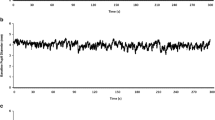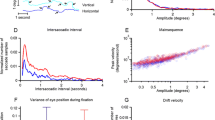Abstract
A total of 940 young men performed a task in which they actively maintained fixation for 50 s in three conditions: a) on a visual target, b) on a visual target while distracting targets appeared briefly on the periphery and c) with no visual target present. The same individuals completed psychometric evaluation tests measuring IQ, schizotypy and current state-dependent psychopathology. The proportion of fixation time decreased and saccade frequency increased in condition b compared wih condition a, and sequentially in condition c compared with condition b. A trend towards a decrease in proportion of fixation time and increase in saccade frequency was found as the subjects maintained fixation during the task and this time-dependent deterioration of performance was again most pronounced in condition c, less so in condition b and absent in condition a. Psychometric test scores were significantly correlated with fixation performance in the population. Worse performance in all three fixation conditions was observed for individuals with lower IQ scores. A deterioration of fixation performance with time in condition b was correlated with disorganization characteristics of schizotypy, suggesting that these individuals had difficulty maintaining active fixation in the presence of increased inhibitory load. A connection of such a difficulty with the frontal lobes and their role in the control of voluntary inhibitory functions is discussed.


Similar content being viewed by others
References
Amador XF, Sackeim HA, Mukherjee S, Halperin R, Neeley P, Maclin E, Schnur D (1991) Specificity of smooth pursuit eye movement and visual fixation abnormalities in schizophrenia. Comparison to mania and normal controls. Schizophrenia Res 5:135–144
Amador XF, Malaspina D, Sackeim HA, Coleman EA, Kaufmann CA, Hasan A, Gorman JM (1995) Visual fixation and smooth pursuit eye movement abnormalities in patients with schizophrenia and their relatives. J Neuropsych Clin Neurosci 7:197–206
Carpenter WT Jr, Heinrichs DW, Wagman AMI (1988) Deficit and non-deficit forms of schizophrenia: the concept. Am J Psychiatry 145:578–583
Chapman LJ, Chapman JP, Raulin ML (1978) Body image aberration in schizophrenia. J Abnorm Psychol 87:399–407
Clementz BA, McDowell JE, Zisook S (1994) Saccadic system functioning among schizophrenia patients and their first-degree biological relatives J Abnorm Psychol 103:277–287
Cloninger CR, Svrakic DM, Przybeck TR (1993) A psychobiological model of temperament and character. Arch Gen Psychiatry 50:975–990
Curtis CE, Calkins MA, Iacono WG (2001) Saccadic disinhibition in schizophrenia patients and their first-degree biological relatives. Aparametric study of the effects of increasing inhibitory load. Exp Brain Res 137:228–236
Derogatis LR, Lipman RS, Rickels K, Uhlenhuth EH, Covi, L (1974) The Hopkins Symptom Checklist (HSCL): a self-report symptom inventory. Beh Science 19:1–15
Evdokimidis I, Smyrnis N, Constantinidis TS, Stefanis NC, AvramopoulosD, Paximadis C, Theleritis C, Efstratiadis C, KastrinakisG, Stefanis CN (2002) The antisaccade task in a sample of 2,006 young males: I. Normal population characteristics. Exp Brain Res 147:45–52
Eysenck HJ, Eysenck SBG (1976) Psychoticism as a dimension of personality. Hodder & Stoughton, London
Fukushima J, Fukushima K, Morita N, Yamashita I (1990) Further analysis of the control of voluntary saccadic eye movements in schizophrenic patients. Biol Psychiatry 28:943–958
Goldman-Rakic (1988) Topography of cognition:parallel distributed networks in primate association cortex. An Rev Neurosci 11:137–156
Gooding DC (1999) The role of executive control in saccade generation. Beh Brain Sci 22:686–687
Gooding DC, Grabowski JA, Henderhot CS (2000) FIxation stability in schizophrenia, bipolar, and control subjects. Psychiatry Res 97:119–128
Johnson MH (1990) Cortical maturation & development of visual attention in early infancy. J Cogn Neurosci 2:81–95
Kissler J, Clementz BA (1998) Fixation stability among schizophrenia patients. Neuropsychobiology 38:57–62
Lenzenweger MF (1994) Psychometric high-risk paradigm, perceptual aberrations and schizotypy: an update. Schizophrenia Bull 20:121–135
Mialet J, Pichot J (1981) Eye-tracking patterns in schizophrenia. An analysis based on the incidence of saccades. Arch Gen Psychiatry 38:183–186
Meehl PE (1989) Schizotaxia revisited. Arch Gen Psychiatry 46:935–944
Munoz D, Wurtz R (1993a) Fixation cells in monkey superior colliculus I.Characteristics of cell discharge. J Neurophysiol 70:559–575
Munoz D, Wurtz R (1993b) Fixation cells in monkey superior colliculus. II. Reversible activation and deactivation. J Neurophysiol 70:576–589
Munoz DP, Istvan PJ (1998) Lateral inhibitory interactions in the intermediate layers of the monkey superior colliculus. J Neurophysiol 79:1193–1209
Ntonias S, Karastergiou A, Manos N (1990) Standardization of the symptom checklist 90-R rating scale in a Greek population. Psychiatriki 2:42–48
Paus T (1991) Two modes of central gaze fixation maintenance and oculomotor distractibility in schizophrenics. Schizophrenia Res 5:145–152
Pierrot-Deseilligny C, Muri RM, Ploner CJ, Gaymard PB, Demeret S, Rivaud-Pechoux S (2003) Decisional role of the dorsolateral prefrontal cortex in ocular motor behavior. Brain 126:1460–1473
Raine A (1991) The SPQ: a scale for the assessment of schizotypal personality in a non-clinical sample-the role of task demand. Schizophrenia Bull 17:555–564
Reynolds CA, Raine A, Mellingen K, Venables PH Mednick SA (2000) Three-factor model of schizotypal personality: invariance across culture, gender, religious affiliation, family adversity, and psychopathology. Schizophrenia Bull 26:603–618
Sansbury RV, Skavenski AA, Haddad GM, Steinman RM (1973) Normal fixation of eccentric targets. J Opt Soc America 63:612–614
Smyrnis N, Evdokimidis I, Stefanis NC, Constantinidis TS, AvramopoulosD, Theleritis C, Paximadis C, Efstratiadis C, KastrinakisG, Stefanis CN (2002) The antisaccade TASK in a sample of 2006 young males: II. Effect of task parameters. Exp Brain Res 147:53–63
Smyrnis N, Evdokimidis I, Stefanis NC, Avramopoulos D, Constantinidis TS, Stavropoulos A, Stefanis CN (2003) Antisaccade performance of 1273 men: effects of schizotypy, anxiety and depression. J Abnorm Psychol 112:403–414
Stefanis NC, Smyrnis N, Avramopoulos D, Evdokimidis I, Tzoufras I, Stefanis CN (2003) Factorial composition of self rated schizotypal traits amongst young males undergoing military training. Schizophrenia Bull (in press)
Thaker GK, Cassady S, Adami H, Moran M, Ross DE (1996) Eye movements in spectrum personality disorders: comparison of community subjects and relatives of schizophrenic patients. Am J Psychiatry 153:362–368
Weinberger DR (1988) Schizophrenia and the frontal lobe. Trends in Neurosci 11:367–370
Wurtz RH, Goldberg ME (1971) Superior colliculus cell responses related to eye movements in awake monkeys. Science 171:82–84
Wurtz RH, Goldberg ME (1972) Activity of superior colliculus in behaving monkeys III. Cells discharging before eye movements. J Neurophysiol 35:575–586
Acknowledgments
This work was supported by the grant “EKBAN 97” to Professor C.N. Stefanis from the General Secretariat of Research and Technology of the Greek Ministry of Development. The technical support for this project was provided by Intrasoft Co. We would like to thank the commanders in chief and the military personnel of the “124” Base for Basic Training of the Hellenic Air Force. A preliminary report on this work was presented in the Society for Neuroscience meeting 2000.
Author information
Authors and Affiliations
Corresponding author
Rights and permissions
About this article
Cite this article
Smyrnis, N., Kattoulas, E., Evdokimidis, I. et al. Active eye fixation performance in 940 young men: effects of IQ, schizotypy, anxiety and depression. Exp Brain Res 156, 1–10 (2004). https://doi.org/10.1007/s00221-003-1759-z
Received:
Accepted:
Published:
Issue Date:
DOI: https://doi.org/10.1007/s00221-003-1759-z




